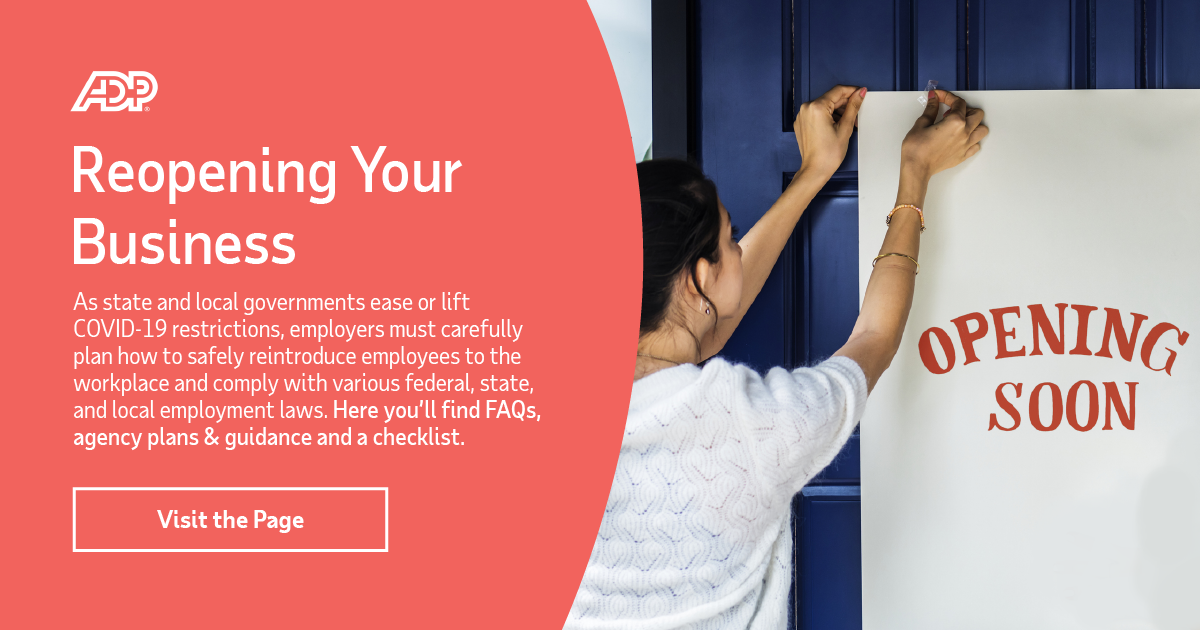When state and local governments ease COVID-19 restrictions, employers must carefully plan when to bring employees back, who to bring back, and how to safely reintroduce them to the workplace. Here are some guidelines to consider.
When:
At a minimum, the decision to reopen must comply with federal, state, and local orders and guidance. Review applicable directives to determine whether you're permitted to resume operations. In many places, the return to work process is occurring in phases with certain types of businesses permitted to resume limited operations before others are allowed to do so. Employers may be required to meet certain requirements when reopening, such as providing employees with protective equipment, training staff, posting notices and/or submitting a return to work plan to demonstrate that they've implemented appropriate protocols to allow for a safe reentry. If conflicts exist among directives and guidelines, consider consulting legal counsel.
To the extent possible, employers should allow employees to telework, considering which employees can continue to work remotely. Even where employers are permitted to allow employees back into the workplace, they should independently assess whether it is safe to do so. Consider the potential risk of transmission in your workplace and safety protocols that you can implement in order to limit the risk, such as enhanced cleaning practices and social distancing measures.
Who:
Even when employers are permitted to reopen, they may be unable to bring back all their employees at first. For instance, there may be state or local restrictions on the number of people allowed in the workplace, social distancing requirements may limit the number of workers that can be in the workplace safely, or the employer simply won't have enough work for all employees.
Determining who is most critical:
Employers should consider having employees return to work in waves, starting with the most critical workers first. Identify the positions that are most necessary to resume operations. Make sure all decisions related to bringing back employees are neutral and job-related. For example you might choose to bring back workers based on business need, seniority, performance, or job classification. Document your objective, job-related reasons for determining which employees to call back to work and when.
Ensuring nondiscrimination:
Never base employment decisions on protected characteristics, such as age, race, pregnancy, disability or other factors unrelated to the job. Employers may have questions about bringing back employees who they know have a condition that puts them at higher risk from COVID-19. Keep in mind that the EEOC has stated that an employer may not exclude an employee – or take any other adverse action – solely because the employee has a condition potentially placing them at "higher risk for severe illness" if they get COVID-19. For more information, see question G4 in the EEOC guidance here.
Employers should also avoid making decisions about who to bring back based on whether the employee may use or has used leave to which they are entitled under federal, state, or local law.
Maintaining staffing levels for PPP loan forgiveness:
Loan forgiveness under the Paycheck Protection Program (PPP) is another factor to consider when recalling employees. Employers that receive a PPP loan may be eligible for forgiveness of the loan if they meet certain criteria, one of which is maintaining staff levels.
To determine whether adequate staffing levels have been maintained, the average number of full-time equivalent employees (FTEEs) during the Covered Period or Alternative Payroll Covered Period will be compared to one of two time periods.
If the number of FTEEs during the Covered Period or Alternative Payroll Covered Period is lower than the time period chosen, the amount of loan forgiveness may be reduced proportionately.
However, reductions in staffing occurring between February 15 and April 26, 2020 will not be considered in reducing the loan forgiveness amount if they are reversed by December 31, 2020.
Loan forgiveness will not be reduced based on an inability to rehire employees if the employer can document: (1) written offers to rehire individuals who were employees of the company on February 15, 2020; or (2) an inability to hire similarly qualified employees for unfilled positions by December 31, 2020.
Additionally, forgiveness will not be reduced for failure to maintain employment levels if the company is able to document an inability to return to the same level of business activity as existed prior to February 15, 2020, due to compliance with COVID-19-related guidance for sanitation, social distancing, or worker or customer safety requirements from the Health and Human Services (HHS), the Centers for Disease Control and Prevention (CDC), or the Occupational Safety and Health Administration (OSHA) between March 1 and December 31, 2020.
The documentation required would be satisfied if an employer made a good faith, written offer of rehire at the same salary/wages and for the same number of hours and the employee rejected the offer of rehire, and the employer notified the applicable state unemployment insurance office of the employee’s rejection of rehire within 30 days. Employees who are terminated for cause, voluntarily resign, or voluntarily request and receive a reduction of hours may also be excluded from the FTEE reduction calculations.
Employees who are reluctant to return:
When you are ready to reopen, you may face employees who are reluctant to return to the workplace due to safety concerns. It's important to communicate the steps your company is taking to maintain employee safety, such as increased cleaning, providing personal protective equipment, and mandating social distancing. You may also want to consider having employees voluntarily return to work at first.
Employees who ultimately refuse to report to work may have protections from adverse action. For example, under the Occupational Safety and Health Act, employees may have the right to refuse to work if all of the following conditions are met:
- Where possible, they've asked the employer to eliminate the danger, and the employer failed to do so;
- They genuinely believe that an imminent danger exists;
- A reasonable person would agree that there is a real danger of death or serious injury; and
- There isn't enough time, due to the urgency of the hazard, to get it corrected through regular enforcement channels, such as requesting an OSHA inspection.
Section 7 of the National Labor Relations Act (NLRA), which grants employees the right to act together to improve wages and working conditions, may also come into play in this situation.
Employees may also have certain rights under state and local COVID-19 orders and/or may be entitled to leave under federal, state, and local leave laws. Or the employee may be hesitant to return because they have an underlying condition and have legitimate health concerns about returning to work.
Alternatives to Layoffs:
If you are facing a situation in which there simply isn't enough work to bring back all your employees at their regular hours, there may be alternatives to layoffs. For example, many states have a Shared Work Program. These programs generally allow employers to reduce employees' work schedules during business slowdowns such as the COVID-19 crisis while supplementing workers with unemployment benefits for the reduction in work.
Layoffs:
If you determine you will have to permanently reduce the size of your workforce, make sure you follow federal, state, and local rules regarding advance notice, nondiscrimination, benefits continuation, and unemployment insurance.
How:
Notifying employees:
Consider sending recalled employees a letter explaining the timeline for reopening, what steps you are taking to protect them from COVID-19, and a deadline for them to confirm that they will return. Include the terms of employment, highlighting any changes in pay, benefits, leave, policies or procedures, contact information for questions, and an at-will employment statement.
Reasonable accommodations:
The ADA and similar state laws require employers to provide reasonable accommodations to individuals with disabilities, unless doing so would impose an undue hardship on the employer. An employee with a disability that puts them at high risk for complications from COVID-19 may request a reasonable accommodation to reduce their chances of infection, such as asking to telework, for personal protective equipment, or for paid or unpaid leave if their job isn't conducive to telework. Additionally, if the employer requires employees to wear protective equipment, an employee with a disability may ask for an accommodation if they are unable to comply because of their disability. Respond to such requests in compliance with applicable laws.
Leave requests:
Employees may be entitled to leave under federal, state, and/or local law, which may complicate the return to work process. While certain leave requirements were in place long before the COVID-19 crisis, other leave laws were enacted in response to COVID-19. For instance, under the federal Families First Coronavirus Response Act (FFCRA) if an employee is unable to work because their child's school is still closed, they may entitled to up to 12 weeks of job-protected leave. The FFCRA also permits paid leave for additional COVID-19 related reasons, and a number of states have their own COVID-19 related leave rules. Review all applicable federal, state, and local leave rules to ensure compliance.
Notices:
Various laws require that employees complete certain paperwork and employers provide certain notices at the time of hire. Some address situations in which an employee is returning after a furlough or layoff. For instance, an employer won't generally need to complete a new Form I-9 (to establish identity and work authorization) if the worker is continuing in their employment following a temporary layoff for lack of work. If this standard cannot be met, the employer must follow the instructions for "rehired" employees in the USCIS Handbook for Employers. For other new hire paperwork and notice requirements, check your applicable laws to determine whether there's an impact on employees returning to work.
Conclusion:
Follow applicable guidelines and orders and develop a plan for when, who, and how to return employees to work safely. Guidelines for returning to work continue to evolve. Monitor the Reopening Your Business page of our COVID-19 Resource Center for updates and listen to our podcast, Reopening Your Business As COVID-19 Restrictions Ease.

